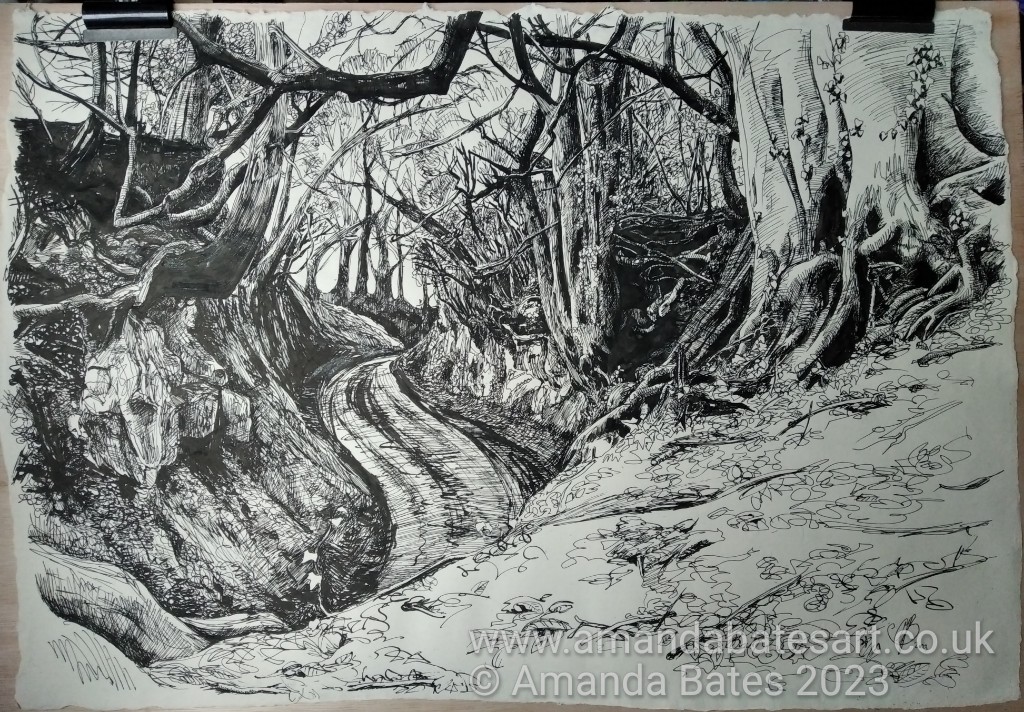Multistorey is a drawing of Hartley Mauditt Lane in East Hampshire, from the vantage of a public footpath that runs alongside and above the sunken lane itself. The drawing is in Indian ink on a full Imperial size sheet of handmade Sunn Hemp paper.
It has been exhibited at the Open Studios INSIGHT exhibition in 2023 and at the SGFA Open Exhibition 2024, where it won the Monochrome Award.
Note that I have no plans to make any prints or greetings cards of this drawing.
The location and the drawing
I have a particular interest in tree-lined sunken lanes or holloways. They are usually ancient routes that have been worn into soft sedimentary rock (such as chalk or sandstone) by the passage of many feet, often aided by water. The most dramatic examples are those with steep cliffs of bedrock either side and mature trees clinging to the edges, and these are the ones that I most enjoy. Many of the surviving examples are now minor roads, like this one.
Hartley Mauditt, near Alton, now seems to consist of a lonely church and a couple of houses, but the site of a medieval village is marked on the map near the church. The lane bearing the settlement’s name crosses a greensand ridge on its way to Alton, and this is where it gets interesting.
I found the site by accident one clear day in January, when I was in the area specifically to visit a different sunken lane as part of a planned walk. I had intended to park by Hartley Mauditt church but was rather dismayed by the loneliness of the spot and was looking for an alternative place to leave my car. I didn’t find one (and my car survived the resultant solitude), but I did find this beautiful spot. Upon investigating on foot, I discovered that there was a footpath up the side that had both its own delights and this lovely view. It was also much safer to linger on than the road was.
The drawing is based on several of the many photographs that I took that day, and while it would probably not match a single wide angle view (I use a 35mm prime lens on my APS-C digital camera, which roughly translates to a standard view – neither wide angle nor telephoto), it does reflect my recalled experience of the view. I hope that it also conveys my wonder and my sense of discovery.
The ink
Indian ink is a trusted lightfast pigment ink invented in ancient China (it was subsequently traded to the West via India). It is made from “lamp black”, essentially, amorphous carbon. It is lightfast, waterproof and very, very black.
The paper
The paper has a story of its own. The following is the description given by Khadi Papers on their web site (www.khadi.com):
Traditional Islamic paper from North India made from a mix of raw sunn hemp fibre and recycled sunn hemp. Handmade on a chapri, a grass stem screen, the impression of the screen is visible on the sheet as a laid pattern. Sheets are dried on a plaster wall and surface sized with wheat starch. The paper is pressed between zinc sheets to make the smooth surface. Vegan.
This paper is made for Khadi Papers by Mahomed Hussain Kagzi, perhaps the last surviving maker of traditional Islamic paper.
The paper is used for calligraphy and fine brush and pen work.
I selected the paper for its warm creamy colour, its gorgeous, genuine “deckle” edge (a result of it being handmade) and its smooth surface, ideal for fine penwork.
Multistorey is the first finished drawing that I have made on the paper, and I am very pleased with the surface. I hope to make more drawings on Sunn Hemp paper.
My pens
I use fountain pens with Indian ink. This is not strictly conventional (Indian Ink is not fountain-pen-friendly, but there are a few pens that tolerate the stuff), but it is convenient (the usual alternative is a dip pen). Please do not put Indian Ink in any fountain pen without understanding the consequences.
I used a Noodler’s Boston and an assortment of Pilot Parallel pens.
Amanda Bates
March 2023



